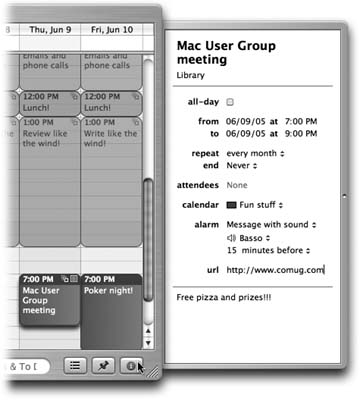10.9. iCal In many ways, iCal is not so different from those "Hunks of the Midwest Police Stations" paper calendars people leave hanging on the walls for months past their natural life span. But iCal offers several advantages over paper calendars. For example: -
It can automate the process of entering repeating events, such as weekly staff meetings or gym workout dates. -
iCal can give you a gentle nudge (with a sound, a dialog box, or even an email) when an important appointment is approaching. -
iCal can share information with your Address Book program, with Mail, with your iPod, with other Macs, with "published" calendars on the Internet, or with a Palm organizer. Some of these features require one of those .Mac accounts described in Chapter 19, and some require iSync (Chapter 19). But iCal also works fine on a single Mac, even without an Internet connection. -
iCal can subscribe to other people's calendars. For example, you can subscribe to your spouse's calendar, thereby finding out when you've been committed to afterdinner drinks on the night of the big game on TV. 10.9.1. Working with Views When you open iCal, you see something like Figure 10-4. By clicking one of the View buttons on the bottom edge of the calendar, you can switch among any of these views: -
Day shows the appointments for a single day in the main calendar area, broken down by time slot. If you choose iCal  Preferences, you can specify what hours constitute a workday . This is ideal both for those annoying power-life people who get up at 5 a.m. for two hours of calisthenics, as well as for the more reasonable people who sleep until 11 a.m. before rolling out of bed and heading over to the home office in the den. This same dialog box lets you limit the number of hours visible in each Day view; choose from the "Show __ hours at a time pop-up menu. As you make this number lower, the time slots get larger, for your nearsighted pleasure . Preferences, you can specify what hours constitute a workday . This is ideal both for those annoying power-life people who get up at 5 a.m. for two hours of calisthenics, as well as for the more reasonable people who sleep until 11 a.m. before rolling out of bed and heading over to the home office in the den. This same dialog box lets you limit the number of hours visible in each Day view; choose from the "Show __ hours at a time pop-up menu. As you make this number lower, the time slots get larger, for your nearsighted pleasure .
Tip: iCal provides a quick way to get to the current day's datechoose View  Go to Today, or press -T. Go to Today, or press -T.
-
Week fills the main display area with seven columns , reflecting the current week. (You can change the display to a five-day work week instead in iCal  Preferences.) Preferences.) -
Month shows the entire month that contains the current date. Double-click a date number to jump to the day view for that date.
Tip: To save space, iCal generally doesn't show you the times of your appointments in Month view. If you'd like to see them anywaymaybe because you have a Cinema Displaychoose iCal  Preferences, click General, and turn on "Show time in month view." Preferences, click General, and turn on "Show time in month view."
Tip: If your mouse has a scroll wheel, you can use it to great advantage in iCal. For example, when entering a date, turning the wheel lets you jump forward or backward in time. It also lets you change the priority level of a To Do item you're entering, or even the time zone as you're setting it.
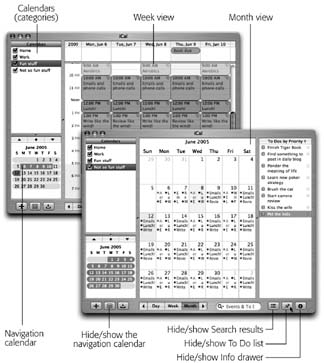 | Figure 10-4. Left: Week view. The miniature navigation calendar provides an overview of adjacent months. You can jump to a different week or day by clicking the triangle buttons, and then clicking within the numbers . If the event is recurring, its upper "grip strip" shows two stacked squares.
Right: Month view. You can hide the To Do list either by using the Window  Hide To Dos command or by clicking the thumbtack button identified here. Hide To Dos command or by clicking the thumbtack button identified here. | |
10.9.2. Making an Appointment The basic iCal calendar is easy to figure out. After all, with the exception of one unfortunate Gregorian incident, we've been using calendars successfully for centuries. Even so, there are two ways to record a new appointment: a simple way and a more flexible, elaborate way. 10.9.2.1. The easy way You can quickly record an appointment using any of several techniques, listed here in order of decreasing efficiency: -
Double-click the appointed time on the calendar, in any view. A colored box appears; this is where you type the name for your new appointment. -
When viewing a day or week view, drag vertically through the time slots that represent the appointment's duration, and then type inside the newly created colored box. -
Using the month view, double-click in a blank area of the appropriate date's square, and then type in the newly created colored bar. -
Choose File  New Event (or press -N). A new appointment appears on the currently selected day, regardless of the current view. New Event (or press -N). A new appointment appears on the currently selected day, regardless of the current view. -
In any view, Control-click a date and choose New Event from the shortcut menu. Unless you use the drag-over-hours method, a new event believes itself to be one hour long, but you can adjust its duration by dragging the bottom edge vertically. Drag the dark top bar up or down to adjust the start time. In many cases, that's all there is to it. You have just specified the day, time, and title of the appointment. Now you can get on with your life. 10.9.2.2. The long way The information drawer shown in Figure 10-5 contains all the details for a certain appointment. (If it's not already open, you can open a selected event's drawer using any of the techniques described in Figure 10-5.) Using this drawer , you can create far more specific appointments, decked out with far more bells and whistles. For each appointment, you can Tab your way to the following information areas: -
Subject . That's the large, bold type at the topthe name of your appointment. For example, you might type Fly to Phoenix . -
Location . This field makes a lot of sense; if you think about it, almost everyone needs to record where a meeting is to take place. You might type a reminder for yourself like My place , a specific address like 212 East 23 , or some other helpful information like a contact phone number or flight number. -
all-day . An "all-day" event, of course, refers to something that has no specific time of day associated with it: a holiday, a birthday, a book deadline. When you turn on this box, you see the name of the appointment jump to the top of the iCal screen, in the area reserved for this kind of thing (see Figure 10-4). -
from, to . You can adjust the times shown here by typing, clicking buttons, or both. Press Tab to jump from one setting to another, and from there to the hours and minutes of the starting time. For example, start by clicking the hour, then increase or decrease this number either by pressing your up and down arrow keys or by typing a number. Press Tab to highlight the minutes and repeat the arrow buttons-or-keys business. Finally, press Tab to highlight the AM/PM indicator, and type either A or P or press the up or down arrow keyto change it, if necessary.
Tip: If you specify a different ending date, a banner appears across the top of the calendar.
-
repeat . The pop-up menu here contains common options for recurring events: every day, every week, and so on. It starts out saying None. Once you've made a selection, you get an end pop-up menu that lets you specify when this event should stop repeating. If you choose "Never," you're stuck seeing this event repeating on your calendar until the end of time (a good choice for recording, say, your anniversary, especially if your spouse might be consulting the same calendar). You can also turn on "after"(a certain number of times), which is a useful option for car and mortgage payments. And if you choose "on date," you can specify the date that the repetitions come to an end; use this option to indicate the last day of school, for example. -
attendees . If the appointment is a meeting or some other gathering, you can type the participants ' names here. If a name is already in your Address Book program, iCal proposes auto-completing the name for you. (Alternatively, you can use the "attendees" label as a pop-up menu; choose Open Address Book, find the person you want, and drag the name directly into the attendees spot.) If you separate several names by commas, iCal automatically turns each into a shaded oval pop-up button. You can click it for a pop-up menu of commands like Remove Attendee and Send Email. (That last option appears only if the person in your Address Book has an email address, or if you typed a name with an email address in brackets, like this: Chris Smith <chris@yahoo.com>.) Once you've specified some attendees, a Send button appears at the bottom of the Info drawer. If you click it, iCal fires up Mail and prepares ready-to-send messages, each with an iCal.ics attachment: a standard calendar-program invitation file. Your guest will get an email message that says,"Chris Smith has invited you to the event: Company Hoedown, scheduled for Wednesday, February 02, 2005 at 3:00 PM. To accept or decline this invitation, click the link below." Unfortunately, there generally is no link below unless your guests happen to use Mac OS X and Mail. It's a great idea for a feature, but extremely limited in scope at the moment. If your lucky recipient does use Mail, clicking the iCal.ics attachment opens up a dialog box that offers Accept and Decline. When your guest clicks one of these buttons, an RSVP message goes back to you. Once Mail has downloaded the response, you've opened its attachment, and you've clicked OK, iCal updates the invitee's status in the Event Info window. You now see the word Pending, Accepted, or Declined next to each name. (Your guests, meanwhile, will be delighted to find that the appointment has automatically appeared on their calendars.)
Note: Attendees without email addresses disappear from the list the next time you open the event.
-
status . The little icon next to each attendee's name changes as they accept or decline invitations. -
calendar . A calendar , in iCal's confusing terminology, is a subseta categoryinto which you can place various appointments. You can create one for yourself, another for family-only events, another for book-club appointments, and so on. Later, you'll be able to hide and show these categories at will, adding or removing them from the calendar with a single click. Details begin on Section 10.9.5.
Tip: Use this same pop-up menu to change an appointment's category. If you filed something in Company Memos that should have been in Sweet Nothings for Honey-Poo, open the event's information drawer and reassign it. Quick.
-
alarm . This pop-up menu tells iCal how to notify you when a certain appointment is about to begin. iCal can send any of four kinds of flags to get your attention. It can display a message on the screen (with a sound, if you like), send you an email, run a script of the sort described in Chapter 8, or open a file on your hard drive. (You could use this unusual option to ensure that you don't forget a work dead-line by flinging the relevant document open in front of your face at the eleventh hour.) Once you've specified an alarm mechanism, a new pop-up menu appears to let you specify how much advance notice you want for this particular appointment. If it's a TV show you like to watch, you might set up a reminder only five minutes before airtime. If it's a birthday, you might set up a two-day warning to give yourself enough time to buy a present, and so on. -
url . What Apple really means here, of course, is URL a Uniform Resource Locator, better known as a Web address like www.apple.com. If there's a URL relevant to this appointment, by all means type it here. Type more than one, if it will help you; just be sure to separate each with a comma. -
Notes . Here's your chance to customize your calendar event. You can type, paste, or drag any text that you like in the notes areadriving directions, contact phone numbers, a call history, or whatever. Your newly scheduled event now shows up on the calendar, complete with the color coding that corresponds to the calendar category you've assigned. 10.9.3. What to Do with an Appointment Once you've entrusted your agenda to iCal, you can start putting it to work. iCal is only too pleased to remind you (via pop-up messages) of your events, reschedule them, print them out, and so on. Here are a few of the possibilities. 10.9.3.1. Editing events To edit a calendar event's name, double-click it. To edit any of the appointment's other characteristics, you have to open its Info drawer, as described in Figure 10-5.
Tip: If you simply want to change an appointment's "calendar" category, you can bypass the Info drawer. Instead, just Control-click the appointment's name (or anywhere on its block), and choose the category you want from the resulting shortcut menu.
You don't have to bother with this if all you want to do is reschedule an event, however, as described next. 10.9.3.2. Rescheduling events If an event in your life gets rescheduled, you can drag an appointment block vertically in its column to make it later or earlier the same day, or horizontally to another date in day or week view. (If you reschedule a recurring event, iCal asks if you want to change only this occurrence, or this and all future ones.) If something is postponed for, say, a month or two, you're in trouble, since you can't drag an appointment beyond its month window. You have no choice but to open the Info drawer and edit the starting and ending dates or timesor just cut and paste the event to a different date. 10.9.3.3. Lengthening or shortening events If a scheduled meeting becomes shorter or your lunch hour becomes a lunch hour-and-a-half (in your dreams), changing the length of the representative calendar event is as easy as dragging the top or bottom border of its block in any column view (see Figure 10-6).
Tip: In week view, if you've grabbed the top or bottom edge of an appointment's block so that the cursor changes, you can drag horizontally to make an appointment cross the midnight line and extend into a second day.
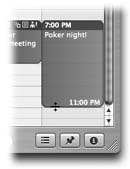 | Figure 10-6. You can resize any iCal calendar event just by dragging its border. As your cursor touches the bottom edge of a calendar event, it turns into a double-headed arrow. You can now drag the event's edge to make it take up more or less time on your calendar. | |
10.9.3.4. Printing events To commit your calendar to paper, choose File  Print, or press -P. The resulting Print dialog box has been dramatically reworked in Tiger. Now you can include only a certain range of dates, only events on certain calendars, with or without to-do lists or mini-month calendars, and so on. Print, or press -P. The resulting Print dialog box has been dramatically reworked in Tiger. Now you can include only a certain range of dates, only events on certain calendars, with or without to-do lists or mini-month calendars, and so on. 10.9.3.5. Deleting events To delete an appointment, just select it and then press the Delete key. If you delete a recurring event (like a weekly meeting), iCal asks whether you want to delete only that particular instance of the event or the whole series from that point forward.
Tip: If you're a laptop-toting traveler , iCal can keep right up with your changing time zones. In iCal  Preferences, click the Advanced tab and turn on "Turn on time zone support." From now on, the Info drawer shown in Figure 10-5 offers a new pop-up menu for each appointment. Its Other command lets you tell it where youll be on that day (you click to pinpoint your location on a tiny world map).Then, as you travel, use the new pop-up menu of time zones in the upper-right corner of iCal's window. You'll see all of your appointments snap to the correct time slots for your current location, so that you're always on time and up-to-date. Preferences, click the Advanced tab and turn on "Turn on time zone support." From now on, the Info drawer shown in Figure 10-5 offers a new pop-up menu for each appointment. Its Other command lets you tell it where youll be on that day (you click to pinpoint your location on a tiny world map).Then, as you travel, use the new pop-up menu of time zones in the upper-right corner of iCal's window. You'll see all of your appointments snap to the correct time slots for your current location, so that you're always on time and up-to-date.
10.9.4. Searching for Events You should recognize the oval text box at the bottom of the iCal screen immediately: It's almost identical to the Spotlight box. This search box is designed to let you hide all appointments except those matching what you type into it. Figure 10-7 has the details. 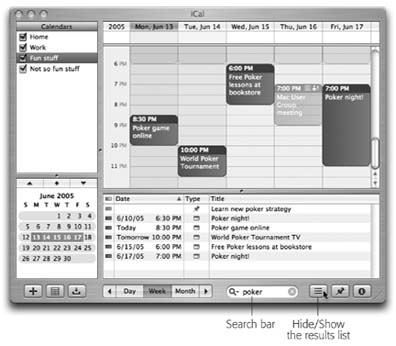 | Figure 10-7. As you type into the search box, iCal filters your calendar until only events with matching text are visible. It screens out both the text list and the colored boxes on the calendar itself, so that you can produce, in seconds, a calendar that shows only events pertaining to a particular client or project. (You can also open up this list view by clicking the rightmost button of the two identified here.) | |
10.9.5. The "Calendar" Category Concept Just as iTunes has playlists that let you organize songs into subsets , and iPhoto has albums that let you organize photos into subsets, iCal has calendars that let you organize appointments into subsets. They can be anything you like. One person might have calendars called Home, Work, and TV Reminders. Another might have Me, Spouse 'n' Me, and Whole Family. A small business could have categories called Deductible Travel, R&D, and R&R. To create a calendar, double-click any white space in the Calendar list (below the existing calendars), or click the + button at the lower-left corner of the iCal window. Type a name that defines the category in your mind.
Tip: Click a calendar name before you create an appointment. That way, the appointment will already belong to the correct calendar.
To change the color-coding of your category, click the  button, or choose View button, or choose View  Show Info ( -I). The Calendar Info drawer appears, looking a lot like the Event Info drawer. Here, you can change the name, color, or description of this category. Show Info ( -I). The Calendar Info drawer appears, looking a lot like the Event Info drawer. Here, you can change the name, color, or description of this category. You assign an appointment to one of these categories using the pop-up menu on its Info drawer, or by Control-clicking an event and choosing a calendar name from the shortcut menu. After that, you can hide or show an entire category of appointments at once just by turning on or off the appropriate checkbox in the Calendars list.
Tip: The Tiger edition of iCal introduces the concept of calendar groups : calendar containers that consolidate the appointments from several other calendars. Super-calendars like this make it easier to manage, print, hide, show, print, and search subsets of your appointments.To create a calendar group , choose File  New Calendar Group. Name the resulting item in the Calendar list; for the most part, it behaves like any other calendar. Drag other calendar names onto it to include them. Click the flippy triangle to hide or show the component calendars. New Calendar Group. Name the resulting item in the Calendar list; for the most part, it behaves like any other calendar. Drag other calendar names onto it to include them. Click the flippy triangle to hide or show the component calendars.
One of iCal's best features is its ability to post your calendar on the Web, so that other people (or you, on a different computer) can subscribe to it, which adds your appointments to their calendars. If you have a .Mac account, then anyone with a Web browser can also view your calendar, right online. For example, you might use this feature to post the meeting schedule for a club that you manage, or to share the agenda for a series of upcoming financial meetings that all of your co-workers will need to consult .  | Figure 10-8. If you click "Publish calendar on .Mac," iCal posts the calendarthe actual, viewable calendaron the Web, as shown in Figure 10-9. If you click "Publish calendar on a private server," you have the freedom to upload the calendar to your own personal Web site, if it's Web-DAV-compatible. In this case, your fans will be able to download (and subscribe to) the calendar, but won't be able to view it online. | |
10.9.6.1. Publishing Begin by clicking the calendar category you want in the left-side list. (To publish more than one calendar, create a calendar group.) Then choose Calendar  Publish; the dialog box shown at top in Figure 10-8 appears. This is where you customize how your saved calendar is going to look and work. You can even turn on "Publish changes automatically," so whenever you edit the calendar, iCal connects to the Internet and updates the calendar automatically. Publish; the dialog box shown at top in Figure 10-8 appears. This is where you customize how your saved calendar is going to look and work. You can even turn on "Publish changes automatically," so whenever you edit the calendar, iCal connects to the Internet and updates the calendar automatically. When you click Publish, your Mac connects to the Web and then shows you the Web address (URL) of the finished page, complete with a Send Mail button that lets you fire the URL off to your colleagues (Figure 10-8, bottom). 10.9.6.2. Subscribing If somebody else has published a calendar, you subscribe to it by choosing Calendar  Subscribe. In the Subscribe to Calendar dialog box, type in the Internet address you received from the person who published the calendar. Alternatively, click the Subscribe button on any iCal Web page (Figure 10-9, lower left). Subscribe. In the Subscribe to Calendar dialog box, type in the Internet address you received from the person who published the calendar. Alternatively, click the Subscribe button on any iCal Web page (Figure 10-9, lower left). Either way, you can also specify how often you want your own copy to be updated ( assuming you have a full-time Internet connection), and whether or not you want to be bothered with the publisher's alarms and notes. 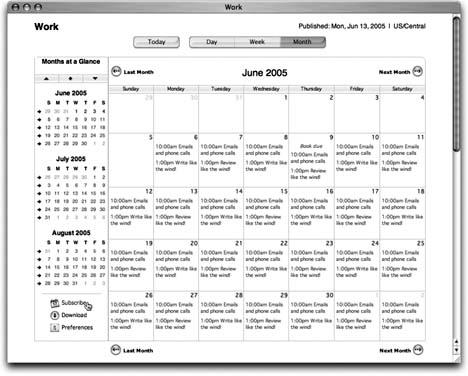 | Figure 10-9. Your calendar is now live on the Web. Your visitors can control the view, switch dates, double-click an appointment for detailsit's like iCal Live! This feature of iCal is a brilliant solution to the old, "My spouse and I each have a Palm, but we can't see each other's calendars" problem. In conjunction with iSync (described starting on Section 19.8.5), each person can now summon the other's calendar to the screen on demand. | |
When it's all over, you see a new "calendar" category in your left-side list, representing the published appointments.
Tip: Want to try it out right now? Visit www.icalshare.com, a worldwide clearinghouse for sets of iCal appointments. You can subscribe to calendars for shuttle launches, Mac trade shows, National Hockey League teams , NASCAR races, soccer matches, the Iron Chef and Survivor TV shows, holidays, and much more. You'll never suffer from empty-calendar syndrome again.
10.9.7. To Do Lists iCal's Tasks feature lets you make a to-do list and shepherds you along by giving you gentle reminders, if you so desire (Figure 10-10). 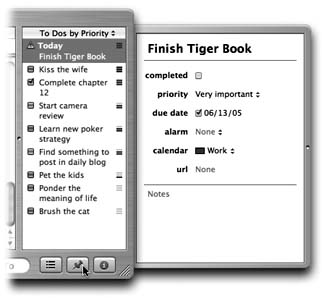 | Figure 10-10. Using the To Do Info drawer (right), you can also give your note a priority, a calendar (category), or a due date. Tasks that come due won't show up on the calendar itself, but a little exclamation point triangle appears in the To Do Items list. | |
To see the list, click the pushpin button at the lower-right corner of the iCal screen. Add a new task by double-clicking in the To Do Items list that appears. In this same Info panel, you can also specify the task's priority, alarm, repeating pattern, and so on. To change a task's priority, use the "priority" pop-up menu. To sort the list (by priority, for example), use the pop-up menu at the top of the to-do list. To delete a task, click it and then press the Delete key.
Tip: You have lots of control over what happens to a task listing after you check it off. In iCal  Preferences, for example, you can make tasks auto-hide or auto-delete themselves after, say, a week or a month. (And if you asked them to auto-hide themselves , you can make them reappear temporarily using the Show All Completed Items command in the pop-up menu at the top of the to-do list.) Preferences, for example, you can make tasks auto-hide or auto-delete themselves after, say, a week or a month. (And if you asked them to auto-hide themselves , you can make them reappear temporarily using the Show All Completed Items command in the pop-up menu at the top of the to-do list.)
|
 Preferences, you can specify what hours constitute a workday . This is ideal both for those annoying power-life people who get up at 5 a.m. for two hours of calisthenics, as well as for the more reasonable people who sleep until 11 a.m. before rolling out of bed and heading over to the home office in the den. This same dialog box lets you limit the number of hours visible in each Day view; choose from the "Show __ hours at a time pop-up menu. As you make this number lower, the time slots get larger, for your nearsighted pleasure .
Preferences, you can specify what hours constitute a workday . This is ideal both for those annoying power-life people who get up at 5 a.m. for two hours of calisthenics, as well as for the more reasonable people who sleep until 11 a.m. before rolling out of bed and heading over to the home office in the den. This same dialog box lets you limit the number of hours visible in each Day view; choose from the "Show __ hours at a time pop-up menu. As you make this number lower, the time slots get larger, for your nearsighted pleasure . 
